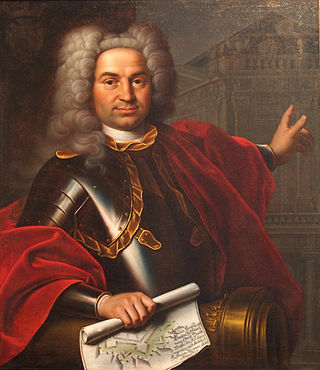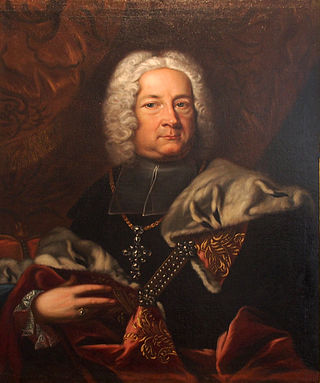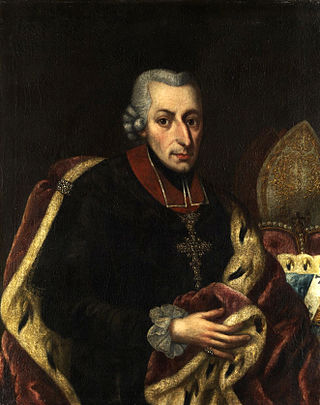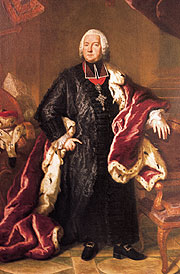
Christoph Franz von Buseck (28 December 1724 - 28 September 1805) was the Roman Catholic bishop of Bamberg and the last Prince-Bishop of Bamberg.

Christoph Franz von Buseck (28 December 1724 - 28 September 1805) was the Roman Catholic bishop of Bamberg and the last Prince-Bishop of Bamberg.
Von Buseck was born in Jagstberg to Ernst Johann Philipp Hartmann von Buseck and Mary Ann. Almost nothing is known of his early life.
On 7 April 1794, von Buseck was elected Prince-Bishop of Bamberg and ordained to the priesthood. His nephew, Georg Karl von Fechenbach, the Prince-Bishop of Würzburg, consecrated him as a bishop on 16 August 1795 and he took office. Von Buseck proved to be a very weak ruler. In 1796, when Bamberg was invaded by the French, von Buseck fled to Prague. When the French invaded Prague in 1799, he fled to Saalfeld. [1] He returned to Bamburg in 1800 and appointed his nephew as his coadjutor bishop and successor.
In the course of the German mediatization of 1802–1803, which saw the suppression of all the Holy Roman Empire ecclesiastical principalities, Bavaria occupied the former prince-bishopric on 29 September 1802 and annexed its territories. However, until his death on 28 September 1805, von Buseck remained bishop of Bamberg, but bereft of any temporal power. He was then succeeded by his nephew. After his nephew's death in 1808, the See remained vacant until 1818, [2] by which time Bamberg had been elevated to an archbishopric following the Bavarian Concordat of June 1817.

Johann Balthasar Neumann, usually known as Balthasar Neumann, was a German architect and military artillery engineer who developed a refined brand of Baroque architecture, fusing Austrian, Bohemian, Italian, and French elements to design some of the most impressive buildings of the period, including the Würzburg Residence and the Basilica of the Fourteen Holy Helpers.

The Prince-Bishopric of Würzburg was an ecclesiastical principality of the Holy Roman Empire located in Lower Franconia, west of the Prince-Bishopric of Bamberg. Würzburg had been a diocese since 743. As established by the Concordat of 1448, bishops in Germany were chosen by the canons of the cathedral chapter and their election was later confirmed by the pope. Following a common practice in Germany, the prince-bishops of Würzburg were frequently elected to other ecclesiastical principalities as well. The last few prince-bishops resided at the Würzburg Residence, which is one of the grandest Baroque palaces in Europe.
Schönborn may refer to:

The House of Schönborn is the name of an ancient noble and formerly sovereign family of the Holy Roman Empire. As a former ruling and mediatized family, it belongs to the Hochadel.

Friedrich Karl von Schönborn was the Prince-Bishop of Würzburg and Prince-Bishop of Bamberg from 1729 to 1746. He also served as Reichsvizekanzler (Vice-Chancellor) of the Holy Roman Empire from 1705 to 1734.

German mediatisation was the major redistribution and reshaping of territorial holdings that took place between 1802 and 1814 in Germany by means of the subsumption and secularisation of a large number of Imperial Estates, prefiguring, precipitating, and continuing after the dissolution of the Holy Roman Empire. Most ecclesiastical principalities, free imperial cities, secular principalities, and other minor self-ruling entities of the Holy Roman Empire lost their independent status and were absorbed by the remaining states. By the end of the mediatisation process, the number of German states had been reduced from almost 300 to 39.

The Diocese of Eichstätt is a Latin Church diocese of the Catholic Church in Bavaria. Its seat is Eichstätt, and it is subordinate to the archbishop of Bamberg. The diocese was created in 745; it was a state in the Holy Roman Empire starting in a Middle Ages until 1805. The current bishop of Eichstätt is Dr. Gregor Maria Hanke, OSB; formerly the Abbot of the Benedictine Abbey of Plankstetten, he was named to the See by Pope Benedict XVI on 14 October 2006, and he was consecrated at the Cathedral of Eichstätt on 2 December 2006. The diocese covers an area of 6,025 km2, with 48.9% of the population being Roman Catholic.

Friedrich Karl Joseph Reichsfreiherr von Erthal was prince-elector and archbishop of Mainz from 18 July 1774 to 4 July 1802, shortly before the end of the archbishopric in the Reichsdeputationshauptschluss.

Franz Ludwig Freiherr von Erthal was the Prince-bishop of Würzburg and Bamberg from 1779 until his death. He was buried at the Würzburg Cathedral.

Johann Dientzenhofer was a builder and architect during the Baroque period in Germany.

The Electorate of Bavaria was a quasi-independent hereditary electorate of the Holy Roman Empire from 1623 to 1806, when it was succeeded by the Kingdom of Bavaria.

The Prince-Bishopric of Bamberg was an ecclesiastical State of the Holy Roman Empire. It goes back to the Roman Catholic Diocese of Bamberg established at the 1007 synod in Frankfurt, at the behest of King Henry II to further expand the spread of Christianity in the Franconian lands. The bishops obtained the status of Imperial immediacy about 1245 and ruled their estates as Prince-bishops until they were subsumed to the Electorate of Bavaria in the course of the German Mediatisation in 1802.

The Diocese of Fulda is a Latin Church diocese of the Catholic Church in the north of the German state of Hessen. It is a suffragan diocese of the Archdiocese of Paderborn. The bishop's seat is in Fulda Cathedral.

Franz von Hatzfeld was the Prince-Bishop of Würzburg from 1631 to 1642 and the Prince-Bishop of Bamberg from 1633 to 1642.

Adam Friedrich Graf von Seinsheim (1708–1779) was the Prince-Bishop of Würzburg from 1755 to 1779 and Prince-Bishop of Bamberg from 1757 to 1779.

Georg Karl Ignaz Freiherr von Fechenbach zu Laudenbach (1749–1808) was the last Prince-Bishop of Würzburg, holding office from 1795 until 1803, when the Prince-Bishopric of Würzburg was mediatised to the Electorate of Bavaria. He continued to serve as Bishop of Würzburg, though without temporal power, until his death. He was also Bishop of Bamberg from 1805 until his death.

Rosenberg Fortress is a fortress situated on a hill overlooking Kronach, a town in the Upper Franconia region of Bavaria, Germany. It is one of the largest, best-preserved, and most complete fortresses in Bavaria. Tracing its origins back to the 13th century, the fortress was never captured by violent means. Originating as a medieval hill castle, it was transformed into a massive baroque fortress complex during the early modern period, being one of the two fortresses of the Prince-Bishopric of Bamberg. With countless construction stages representing centuries of architectural development visible, Rosenberg Fortress serves as an outstanding example of the evolution of defensive architecture in Germany. Including its moats and ravelins, the fortress covers an area of circa 8.5 hectares.